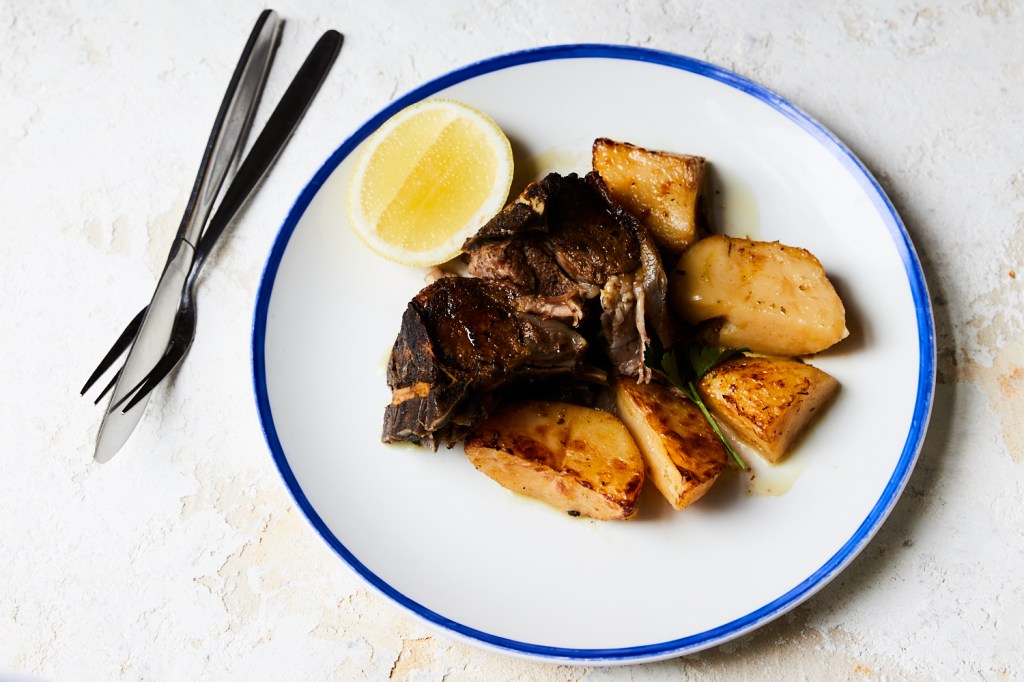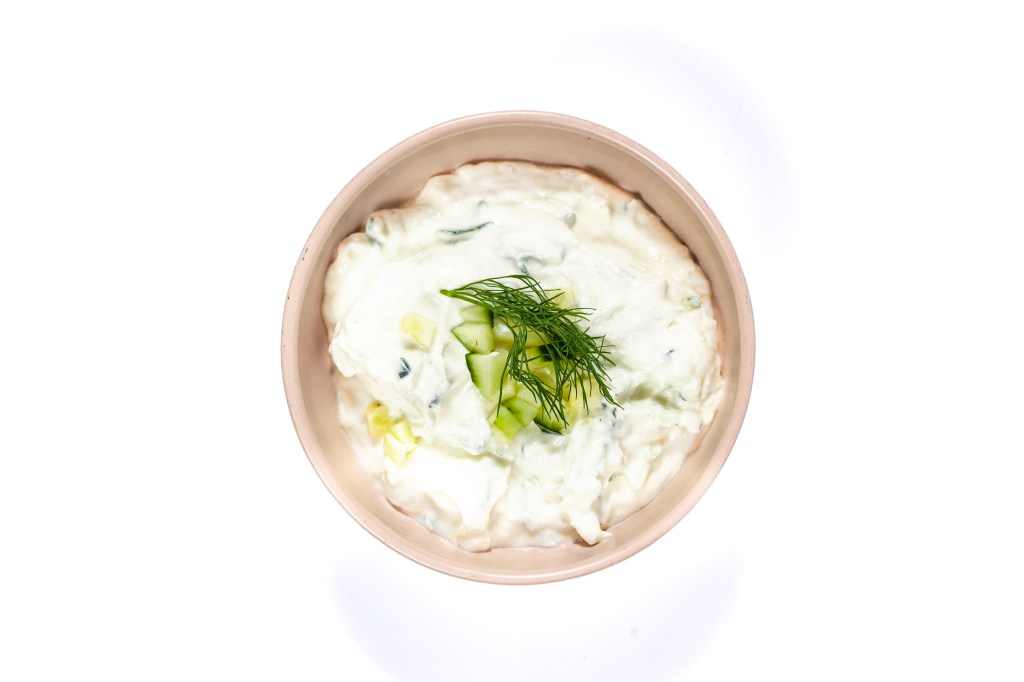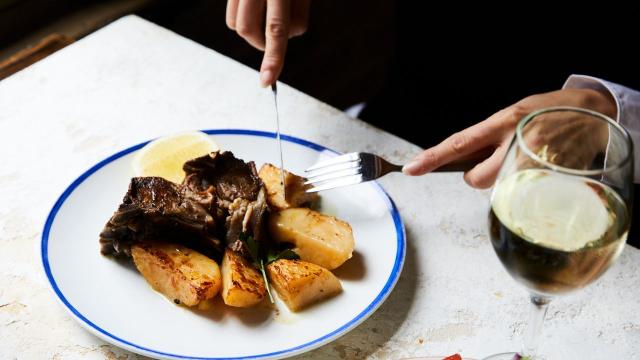It can be hard knowing what to cook for Easter celebrations every year but lucky for us (and you), Nicole Papasavas, the force behind Melbourne’s iconic Greek restaurant Stalactites, has shared her favourite family recipes to whip up for the festive occasion.
Greek Orthodox Easter is set to fall on Sunday, April 16 this year (whereas Catholic Easter Sunday is on April 9), so, Papasavas wanted to share some recipes that should get you ready to entertain ahead of these major dates.
From oven-baked lamb with potatoes lemonato (which mimics traditional techniques of cooking) to fresh tzatziki and even Orthodox dyed Easter eggs, we’ve got everything you need for a perfect Greek Easter celebration right here.
Greek Easter recipes perfect for entertaining
Oven-baked lamb and potatoes lemonato

According to Papasavas, lamb was mainly eaten during times of celebration because it was expensive so it was reserved for special occasions. Lamb is also popular because Orthodox Easter Sunday is held in spring in Greece.
The favourite way to cook this Greek Easter lamb is by putting a full-marinated one on the spit. Sometimes, depending on tradition, families can fill the belly of the lamb with lemon and herb-seasoned potatoes so they slowly cook inside and take on the flavour of the lamb.
What you’ll need to make this Greek Easter recipe:
- 1 full rack lamb with skin, flap etc (or alternatively, a leg with bone or lamb shoulder)
- 500 ml lemon juice
- 1 cup chicken stock
- 3-5 cups water
- 6 cloves of garlic cut in half or one third
- 1 1/2 tablespoon mustard
- 3 tablespoons oregano
- 1 tablespoon sweet paprika
- 1 teaspoon cumin
- 1 1/2 teaspoon pepper
- 1-2 tablespoon salt (to taste)
- 1/2 chopped brown onion
- 1/2 cup olive oil
- 1-1.5 kilograms desiree potatoes
Directions:
- Lay lamb rack in a large shallow baking tray.
- Sprinkle 1 tablespoons oregano, 1 teaspoon pepper, 1/2 tablespoon salt. 1/2 tablespoon paprika, ½ teaspoon cumin over lamb and ½ of the mustard and massage in.
- Flip the lamb over and repeat step 2.
- Pour 250ml cups lemon over lamb making sure all lamb has lemon juice over it by massaging and spreading it while pouring.
- Slice slits in lamb and insert ½ cloves of garlic until all used up.
- Flip over to the side with the skin flap, this is the side to bake it on.
- Chop the onion and sprinkle over the meat, pour 1 cup oil over the meat and add water to the tray until halfway. Bake uncovered for 1 hour at 180 degrees Celsius.
- Chop the potatoes into quarters. In a bowl put potatoes and sprinkle 1 tablespoon oregano, 1 tablespoon salt, ½ tablespoon of paprika and 1/2 teaspoon cumin, ½ cup lemon juice, ½ tablespoon mustard and stock, ¼ teaspoon pepper. Mix well.
- Add potatoes to the baking tray. Submerge the potatoes in the juices from the meat until they are at least half covered. Add water if needed.
- Cover with foil and return to oven for 1 hour.
- Remove foil and return to oven for 1 hour.
Chef’s note: Be generous with the spices and don’t be scared to taste and add more if needed.
Tzatziki recipe

Papasavas says that they make all of their tzatziki in-house at Stalactites. This usually includes hanging the yoghurt overnight to strain the water out, so it’s thick.
What you’ll need to make this Greek Easter recipe:
- 300 g thick Greek yoghurt, strained
- 3 garlic cloves, crushed
- 1 small Lebanese cucumber, grated
- Sea salt to taste
- Pinch of black pepper
- 1 tablespoon vegetable oil
- Half a teaspoon of vinegar
Directions:
- Wash and cut cucumbers in half. Do not peel. Remove seeds if any and grate the cucumbers
- Place in a sieve to drain liquid into a bowl. Squeeze out any excess liquid by placing the cucumber in a tea towel and wringing it
- In a separate bowl, add strained yoghurt, crushed garlic and vinegar. Add the strained cucumbers to the yoghurt, oil, salt and pepper. Stir until combined. Adjust salt and add extra garlic to taste if required
- Store in fridge
Greek Orthodox Easter eggs recipe
If you’ve ever been to a Greek Orthodox Easter, you’ve probably seen the red-dyed eggs. These are traditionally made on Holy Thursday.
The red colour is meant to symbolise the blood of Christ with the eggs being used to celebrate the resurrection on Easter Saturday (after midnight) or Easter Sunday.
According to Papasavas, the Easter eggs are played in a game where two people crack them against each other and say ‘Christ has risen’. The person who successfully cracks the Easter eggs of the other person wins and challenges others. The victor will have good luck for the year.
What you’ll need to make this Greek Easter recipe:
- 12 eggs
- 1 package red egg dye powder (you can buy this from a Greek or Mediterranean grocer)
- 6 cups warm water
- 1/2 teaspoon salt
- 1/3 of a cup of vinegar
- Olive oil for polishing eggs
Directions to make this Greek Easter recipe:
- Take eggs out of the fridge as they need to be at room temperature
- Add cold water to a pot and boil the eggs on low
- Add half a teaspoon of salt in the water to prevent your eggs from cracking
- Bring eggs to a slow boil. As soon as the eggs are boiled, place them under running cold water to stop the cooking process. Let the eggs cool down
- Prepare the dye as per the instructions on the packet. Use a glass bowl as it won’t stain. Dissolve the dye and warm water in the bowl and add vinegar. Lower the eggs carefully in the bowl. Leave for 30 minutes after which you can remove the eggs with a spoon and place them on a baking rack to dry
- Once eggs are dry, polish them with a paper towel and oil
Chef’s tip: Use can use any colour dye to create these colourful Greek Easter eggs but red is the traditional colour. Eggs can be wrapped with onion skins and tied into a pantyhose or a small dried flower and be applied to the egg and wrapped into a pantyhose before submerging in dye to create lovely patterns and designs on the eggs.
If you’re looking for some seafood recipes to try this Easter, try this Greek-style barramundi.

Leave a Reply
You must be logged in to post a comment.